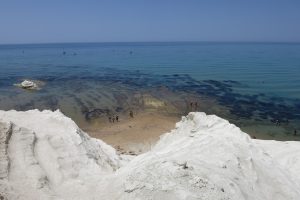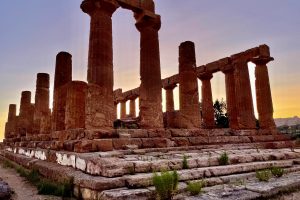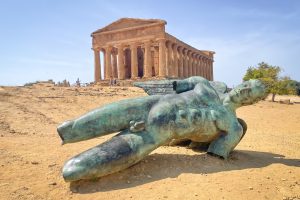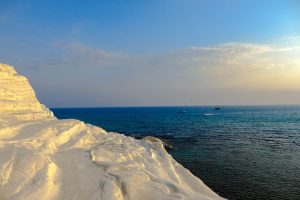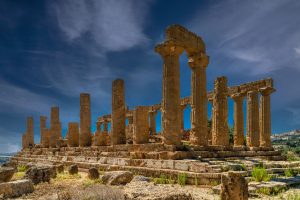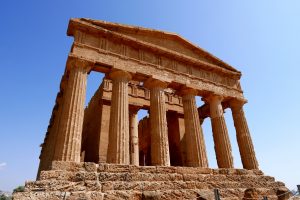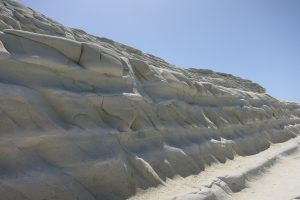Full Day Tour to Temple Valley and Scala dei Turchi from Pozzallo
Today meet the driver at Pozzallo and drive to Agrigento where you will visit on your own the finest of all ancient Greek sites—the complete Doric Temples (Admission fee: not included and to be paid on the spot). The Archaeological Park of the Temple Valley, dated around 5th century B.C., belongs to the Unesco World Heritage and is an unmissable location.
In the afternoon a photo stop at the “Scala dei Turchi“, a rocky cliff of unusual white color that lies between two sandy beaches.
Then return to Pozzallo.
This tour is operated with English speaking Driver.
TOUR DETAILS & BOOKING INFORMATION
STARTING TIME:
Please specify if you have any special require.
AS REGARDS THE TEMPLE VALLEY:
Agrigento & the Temples Valley (Admission fee: not included): two hours walking tour on the Valley of the Temples (Admission fee: not included), a Unesco World Heritage site. Covers the Temple of Hera, the Temple of Concordia, the Temple of Hercules and the Temple of Zeus. Agrigento, according to legend, was founded by Daedalus and his son Icarus after they had fled from Crete “by air”. Historically, however, its origins date back to 582 B.C. when it was founded by Rhodian-cretan colonist from the neighbouring Gela who named their city Akragas after the nearby river of that name. It rapidly increased in size, importance and military strength under Phalarides, the first tyrant, and later under Theron, who extended his sway over northern Sicily as far as Himera.Agrigento was a city of artists and illustrious personages, amongst whom the philosopher Empedocles. Pindar defines it as “the most beautiful of mortal cities” and, in fact, in the Vth century B.C., those famous temples, whose beauty we still admire today, were built.
The Temple of Concord: almost in the centre of the ridge of temples, conspicuous for its nobility and integrity, has defied the centuries. It is, in fact, the best preserved example of Doric art in Italy and conveys a vivid impression of the stateliness and harmony of that art which reaches its loftiest form in western Hellenism. Built in the second half of the Vth century B.C., it has 6 columns on the façade and 13 on either side and stands on a pedestal 4 steps high, 40 metres long and 17 metres wide.
The original dazzling polychromatic decoration, which used to act as a facing to the sandstone structural framework of the temple and completed, and perfected, its architectonic aspect, has all disappeared. In the VIth century A.D. the temple was transformed into a Christian church and of this traces still remain. Every year, in front of its western façade, on the first Sunday in February, folklore groups from many nations gather to celebrate the “Festival of the Almond in Blossom”, a festival in honour of friendship among peoples and the birth of spring.
The Temple of Hercules: dedicated to the mythical hero, son of Jove, was built in the VIth century B.C. and is the most ancient of those existing in Agrigento. Destroyed, it seems, together with the other temples of Agrigento and Selinunte, by an earthquake in the late post-classic age, it is at present a heap of ruins but, in recent years, 8 columns of the southern side have been re-erected. Mighty and massive, these columns are each made up of 4 drums and surmounted by Doric capitals with a sweeping curve.
The Temple of Olympic Jove: built in 480 B.C. after the Agrigentine victory over the Carthaginians at Himera, was an enormous building, the largest in ancient Greece after the Artemision of Ephesus and the Didymeon of Miletus. The base of its imposing ruins measure 112,60 metres by 56,30 and they house a copy of the “telamones”, gigantic Atlases 7,5 metres in height which used to support the architrave. In its architecture, in fact, the temple departed from tradition and introduced an innovation for the period. The architect, in order to sustain the enormous weight of the trabeation to which the columns were submitted, resorted to the ingenious expedient of reinforcing them with these enormous figures of Atlases mounted on semi-columns erected in the intercolumnar spaces of the peristyle. Around the perimeter of the temple one can see the massive semi-columns and half-capitals dispersed by earthquakes. During the 1926 excavations the remains of four other telamones came to light; Agrigento has used these figures in its coat-of-arms.
TOUR CODE: POZSCALA
- Grade
- Days1
- Duration8 Hours
- CategoryDay Tour
- Tour TypePrivate
- SeasonAll Year
